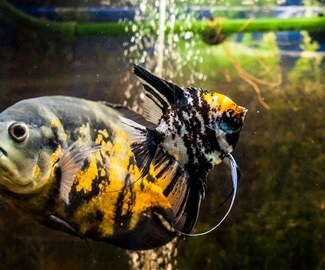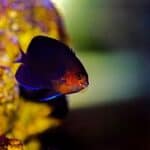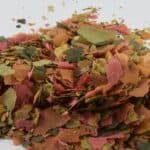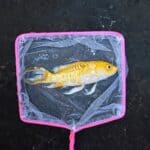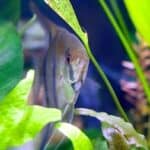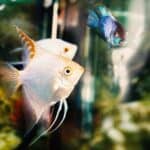Last Updated on: 16th November 2023, 01:29 pm
Hole-in-the-head disease is one of the most common angelfish health conditions.
It’s characterized by holes in the affected fish’s head that can turn white and produce discharge. Angelfish with this disease become sick due to inappetence and resulting infections.
Hole-in-the-head disease, also known as Hexamitiasis, is caused by Hexamita. This is a flagellate parasite. Scientific studies suggest that activated carbon can also bring on the condition.
The most noticeable sign is lesions on the head, which turn into cavities. It can be treated by maintaining good tank hygiene, reducing stress levels, an improved diet, and medications like Metronidazole.
Like many other diseases, poor tank management is a leading cause of hole-in-the-head disease in angelfish. This condition is treatable if diagnosed early.
What Is Hole in The Head Disease in Angelfish?
Hole-in-the-head disease (head and lateral line erosion) is a common parasitic disease affecting certain saltwater and freshwater species, including cichlids, discus, and Oscar fish.
Hole-in-the-head disease is caused by the flagellate parasite called Hexamita.
The condition doesn’t start at the head but inside the intestinal tract. Then, it spreads to the gall bladder, kidneys, and abdominal cavity. It’s not until the disease advances that it reaches the head.
There’s a link between the use of activated carbon and hole-in-the-head disease.
The North American Journal of Aquaculture examined the relationship. Researchers exposed 12 fish to lignite carbon and found that they all developed hole-in-the-head disease within 3 months.
While this idea is still relatively unexplored, it’s thought that carbon removes some of the good nutrients that fish require, increasing Hexamita organisms in the intestine.
Angelfish with hole-in-the-head disease develop lesions on their head and flank. Sometimes, the lesions open up to release a white discharge containing parasitic larvae.
Secondary bacterial and fungal infections can set in, causing severe sickness and death.
What Does Hole in The Head Disease Look Like?
The disease produces translucent, white lesions in the head and lateral line, starting at the sensory pores.
The lesions look like ulcers because the parasite blocks blood vessels, causing the tissue to die. Ulcers form where healthy tissue once appeared.
Lateral lines are faint lines that run down the sides. They start at the gill and end at the base of the tail.
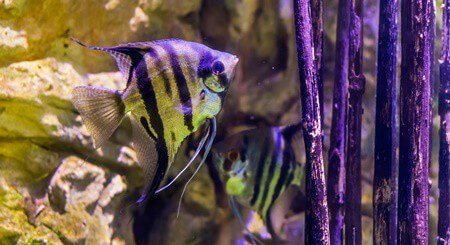
Is Hole in The Head Disease Contagious?
There’s no evidence that hole-in-the-head disease spreads from fish to fish. However, the disease is mainly caused by improper living conditions and poor nutrition.
If one angelfish suffers from hole-in-the-head disease, other fish in the tank do. Consequently, we should conclude that all fish are vulnerable, even if only one fish shows adverse symptoms.
What Are The Causes of Hole-in-The-Head Disease in Fish?
We’ve established that the flagellate parasite (Hexamita) and activated carbon are the main reasons for hole-in-the-head disease, but other factors can be responsible.
There isn’t one cause of hole-in-the-head disease, making it hard to find the cause. Also, most angelfish carry the Hexamita parasite, but it doesn’t affect them in healthy conditions.
Here are the most common causes of hole-in-the-head disease:
Stress
Fish become stressed due to territorial or aggressive fish in the tank and poor tank hygiene.
Integrative and Comparative Biology explains how stress factors that are overly severe or long-lasting threaten the fish’s health. Stress can affect the following:
- Metabolism.
- Hydromineral balance.
- Breathing.
- Immune system.
- Cardiovascular functions.
Stress releases hormones, including adrenaline and cortisol, to give the fish the energy to escape.
Adrenaline affects a fish’s ability to balance the body’s salt and water content, while cortisol reduces the immune system’s efficacy.
Poor Water Quality
Unhygienic conditions inside the tank are a breeding ground for harmful bacteria. Decaying waste matter, dead fish, and rotting food increase ammonia and nitrite levels in the water.
Eventually, the fish’s immune system weakens. It also becomes overly stressed by the low water quality in the aquarium. Consequently, it’ll be more seriously affected by bacteria and infections.
If bacteria grow and accumulate, they can disrupt the tank’s ecosystem. They also kill off all the beneficial bacteria that keep things healthy and clean.
Improper Nutrition
If angelfish lack access to vitamins and minerals, their bodies degenerate.
A lack of calcium, phosphorous, and vitamins C and D contributes to the development of hole-in-the-head disease. This is due to a low-quality diet or infrequent feeding.
The MSD Veterinary Manual explains how it’s dangerous to assume that what’s suitable for one fish species is good for another.
While you may have kept fish before, angelfish need quality flakes, frozen seafood, and the occasional live food that allows angelfish to hunt.
Over-Crowding
When new fish are added to the tank, they introduce new bacteria. The immune systems of some angelfish can’t cope with exposure to unfamiliar bacteria and become ill.
Over-crowding also causes ammonia and nitrite in the tank to rise to harmful levels. Bacteria can’t neutralize these toxins fast enough, making fish in the tank sick.
As a result, fish become stressed and anxious, causing the immune systems to weaken and grow more susceptible to hole-in-the-head-causing bacteria.
To avoid over-stocking, use the water surface area rule, stocking 1 inch of fish every 12 square inches.
Old Age
Older angelfish are more prone to developing and less likely to survive hole-in-the-head disease.
Their bodies become weaker and have difficulty preventing infections and diseases. This leaves their immune systems more vulnerable and less likely to survive an attack.
Early Signs of Hole in The Head Disease in Angelfish
There are 3 noticeable stages to hole-in-the-head disease. As the disease develops and worsens, you’ll notice the angelfish becoming increasingly unwell.
Fish contaminated with Hexamita display the following symptoms:
Stringy Feces
Angelfish with hole-in-the-head disease produce white feces. It may also appear long and stringy. White poop is feces with no food in it. It also indicates Hexamita is present inside the body.
When white feces result from hole-in-the-head disease, the fish isn’t eating. Parasites cause a loss of appetite, so affected angelfish refuse to eat their meals.
Emaciation
As the angelfish struggle to nourish themselves, they become emaciated and look ill. Hole-in-the-head disease starts in the intestines, making eating uncomfortable.
Consequently, starvation will kill the fish if the parasite doesn’t.
Isolation
Angelfish will isolate themselves in the corners and bottom of the tank. They hide their illnesses to stay safe from predators and larger fish that bully them.
Angelfish can only pretend to be well for so long, so isolating themselves and hiding in plants makes them feel somewhat protected.
Fish instinctually stay away from the rest of the school to protect them. While Hexamita isn’t infectious, it’s still deadly and initiates the species’ survival instincts.
Loss of Color
Hole in the head disease causes angelfish to become white and colorless. The fins and tail can also become frayed as the parasite attacks the body.
Enlarged Sensory Pores
One of the main symptoms is lesions of the sensory pores on the head and trunk.
Once the disease progresses, deep holes or pitted wounds appear on the angelfish’s head and lateral line. They begin as pinhole-sized and spread outwards. Many spots can also occur in one place.
Discharge with parasitic larvae are sometimes released from the holes. This gives the holes a white look, a lot like stringy mucus.
Not all fish get white lesions until the later stages, so hole-in-the-head often goes undiagnosed.
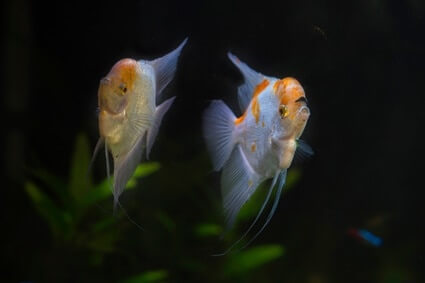
How To Get Rid of Hole in The Head Disease in Fish
Once holes in the angelfish’s head appear, the chances of survival are slim. There’s no cure, but combining treatments can kill the parasite and improve the angelfish’s overall health.
The best treatments for hole-in-the-head disease are as follows:
Clean The Tank
Test the water to check the pH levels. Also, determine if ammonia and nitrites have reached unsafe levels.
To clean the tank, follow these steps:
- Replace 10 to 20% of the tank’s volume with fresh water.
- Dechlorinate the water before adding it, and scrub the sides to remove bacteria and build-up.
- Remove decaying matter, like dead plants and rotting food. Check for dead angelfish.
- Use a siphon to remove decomposing matter from the substrate.
- Clean the filter using the tank’s water to remove gunk. Don’t run it under a faucet because you must preserve the beneficial bacteria.
Once you’ve cleaned the tank, repeat the process every other week. Then, regularly test the water to see if harmful toxins reappear. You should observe an improvement in the fish’s health and well-being.
Improved Diet
Improving the angelfish’s diet with quality food gives them the nutrients needed to stay healthy.
As established, weakened immune systems are among the leading causes of hole-in-the-head disease, so focus on a healthy diet to avoid diseases and infections.
Add a few drops of vitamins into the tank each day to expedite the process. This means that even if the angelfish don’t want to eat, they’ll still get the necessary nutrients.
You can soak their pellets and flakes in vitamins before feeding.
Remove Excess Fish
Put some of the fish in a separate tank. Use the water surface area rule to determine how many fish the tank can safely accommodate. Allow for plants and other accessories in the aquarium.
While an air pump and air stone can increase oxygen levels in the short term, there’s only so much they can do. Not removing excess fish risks harmful ammonia and nitrite levels from returning.
Medication
Once hole-in-the-head disease becomes advanced, the measures above aren’t enough to treat it. You’ll also need an effective medication, like Metronidazole.
Metronidazole is an antibiotic that kills parasites in the intestinal tract, preventing hole-in-the-head disease from worsening.
A study in Vin assessed the effectiveness of standard hole-in-the-head medications on angelfish.
It was found that the Hexamita count dramatically reduced after administering a medicated feed treatment made with Metronidazole. It worked within 24 hours.
The study summarized that the treatment should be effective as long as fish eat.
If the fish are anorexic, a bath treatment can be administered. While it took researchers 3 bath treatments to see the same results as the oral medication, no fatalities occurred.

